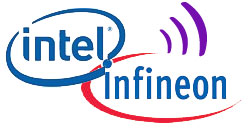It's been rumored for a few months, but on Monday morning, Intel made it official: it is purchasing the Wireless Solutions (WLS) business unit from Infineon Technologies for $1.4 billion.
The purchase gives Intel a one-stop semiconductor offering in its quest to take mobile market share. The company has openly expressed its intentions to target the mobile market with its new Atom processor.
Infineon makes the baseband and RF transceiver chips used in a wide variety of cell phones, most notably the Apple iPhone. It's also used by Nokia, Ericsson, LG and Samsung.
Between the Infineon chips and Atom CPU, that's most of the silicon internals you need to make a cellular phone. All you need at that point is memory, which Intel makes, plus other pieces like power amplifiers, a motherboard, a battery, a screen and a case.
The deal is valued at $1.4 billion and will have to go through the usual regulatory approval in the U.S. and Europe. The two firms said they expect the deal to close in the first quarter of 2011. Intel said the wireless unit will operate as an independent unit in its native Germany, where Infineon is headquartered.
"The global demand for wireless solutions continues to grow at an extraordinary rate," Paul Otellini, Intel president and CEO, said in a statement. "The acquisition of Infineon's WLS business strengthens the second pillar of our computing strategy -- Internet connectivity -- and enables us to offer a portfolio of products that covers the full range of wireless options from Wi-Fi and 3G to WiMAX and LTE. As more devices compute and connect to the Internet, we are committed to positioning Intel to take advantage of the growth potential in every computing segment, from laptops to handhelds and beyond."
Maybe the second time in the mobile signaling market will be the charm for Intel. It purchased DSP Communications for in 1989 $1.6 billion, but the business failed to catch fire. Intel took $600 million in write-downs before selling the business off to Marvell Communications in 2006 for just $600 million.
Infineon, for its part, loses about 30 percent of its revenue, but the wireless business was its smallest business. In announcing the deal, CEO Peter Bauer said the company plans to focus on those market segments now that it has divested the wireless business. Infineon has a much bigger interest in multimedia, chip card and security, and the automotive industry. Automotive is its largest business. The company even owns a race track in northern California called Infineon Raceway .
Buying Infineon makes for a decent revenue stream, but the real benefit is the technology Intel has gained, said semiconductor analyst Nathan Brookwood of Insight 64.
"Ultimately, Intel needs to integrate these kinds of baseband capabilities onto SoCs (systems on a chip) with Atom, and trying to develop this kind of technology from scratch is very hard," he said.
"It makes even more sense when you consider they needed this technology to expand their offerings. Infineon is in the LTE market while Intel was in WiMax. What's not to like?"
LTE , or Long-Term Evolution, is the next generation in high-speed wireless, with a focus on data rates. Data transfer rates over LTE can theoretically reach 100 gigabits per second but are usually lower than that. Initial LTE tests by Verizon Wireless have put LTE in the 40 to 50 Gbps range, which is faster than the fastest cable modem.
Intel has been a big supporter of WiMax , another high-speed wireless solution that's supported by Sprint in the U.S. but has much wider adoption outside of the U.S. Within the U.S., all four major carriers have said they would support LTE but only Sprint is carrying WiMax.
